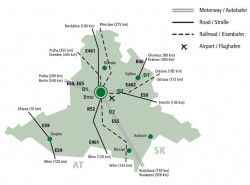South Moravia
Location
The South Moravia region is located in the south and southeast of the Czech Republic. Within the EU it borders Austria and the Slovak Republic. The traditional administration centre of the region is Brno, the second largest city in the Czech Republic. Other important towns in terms of population are Znojmo, Hodonín, Břeclav, Vyškov, Blansko, Kyjov and Veselí nad Moravou.
Investment climate
Metallurgy and metalworks, the food industry, mechanical engineering, production of electrical and optical equipment and medical technologies are among the traditional and most important industries in South Moravia. Industries that hold promise for the future are electrical and optical equipment, information technologies, biotechnologies and nanotechnologies. The South Moravia region is successfully developing favourable conditions for both foreign and domestic investors; new industrial zones and parks are emerging, and existing ones are being enlarged. The high quality of the local secondary and university education system provides sufficient potential for the development of a qualified workforce.
| Basic Data | |
|---|---|
| Land Area | 7,197 km2 |
| Number of municipalities, total | 672 |
| Number of incorporated towns | 47 |
| Number of districts | 7 |
Source: Czech Statistical Office, www.czso.cz (1 January 2005)
Infrastructure
The South Moravia region is traversed by two important thoroughfares - the D1 highway, in one direction to Prague and in the other to Olomouc and Ostrava; and the D2 highway linking Brno directly to the Slovak capital Bratislava.
Brno-Tuřany international airport in Brno offers regular routes to London and Munich. The airport is undergoing complete modernisation and its further development is expected in coming years.
Leisure time and tourism
Brno, the capital of the South Moravia region has a population of 380,000 and is the industrial, business and administrative centre of the region, as well as the seat of universities and judicial bodies. The city is also a centre of trade-fair and conference tourism; each year approximately 50 international trade fairs and exhibitions take place at the Brno Exhibition Grounds. Brno offers sufficient infrastructure both in the area of accommodation capacity as well as accompanying tourist services including a range of cultural, social and sporting events. Thanks to its location and proximity to other European metropolises - Vienna, Budapest and Bratislava - the city is also a starting point for numerous travel programmes, including popular wine tours. Another advantage that Brno possesses is its convenient transport link to Prague. Visitors can use the Brno-Tuřany international airport, and standard transportation services (public transport, taxi and car-rental services) are also available.
Brno and its surroundings offer a rich variety of cultural opportunities, primarily at theatres, museums and galleries (for example, the Moravian Regional Museum in Brno, the Technical Museum, Blansko Museum, the National Theatre in Brno, and the Bolek Polívka Theatre).
Numerous historical landmarks can be found here (for example, the gothic Špilberk castle, http://www.spilberk.cz, Petrov cathedral, Boskovice castle, Pernštejn castle, the chateaux in Slavkov u Brna and Vranov nad Dyjí and others), as well as modern functionalist buildings (for example, the Tugendhat villa, a UNESCO World Heritage site designed by the German architect Ludwig Mies van der Rohe, http://www.tugendhat-villa.cz).
Brno is also a starting point for tourists wanting to experience the natural and cultural beauty of the region (www.jizni-morava.cz). Among the most popular tourist destinations in South Moravia are, for example, the Slavkov battlefield, Moravský kras north of Brno, the Punkva underground stream, and the riparian landscape with Europe's largest riparian forest in the southernmost part of Moravia in the area of the confluence of the Dyje and Morava rivers. The Lednicko-valtický complex and Pálava biosphere preserve (http://www.palava.cz) are listed as UNESCO sites. The area has a long tradition of wine-making and the local wine is inherently associated with Slavonic songs, costumes, dances and crafts.
Another significant regional centre is Znojmo, the second largest city in South Moravia and the centre of the wine-making area. The region's attractiveness is enhanced by Podyjí, one of four Czech national parks, on the banks of the Dyje River. In summer, tourists are primarily attracted by the Vranov dam and other water-recreation areas. Each year a range of enthusiasts are attracted not only by the offer of wine-tourism programmes, but also by cultural and social events such as the Znojmo Wine Festival.
Another renowned wine-making area is the Moravské Slovácko region in the southeast corner of the Czech Republic on the border with Austria and Slovakia. Here visitors will find priceless examples of religious and secular architecture, preserved folk architecture and particularly rich folklore and a tradition of folk culture. The natural borders of the district are comprised of the deep deciduous Ždánický forest and Chřiby Mountains to the north, and the White Carpathian Mountains to the south (The White Carpathians are registered as a UNESCO biosphere preserve, http://www.bilekarpaty.cz).
Attached files
| Description | Type | Size | Date |
|---|---|---|---|
South Moravia Region |
594.94 kB | 28 Apr. 2017 |









